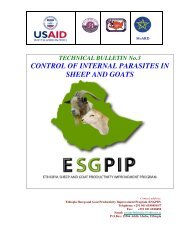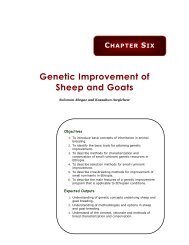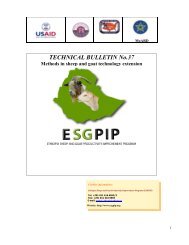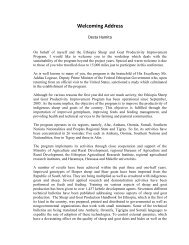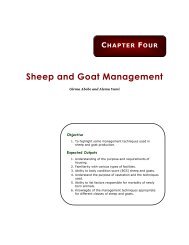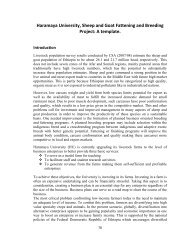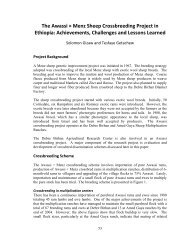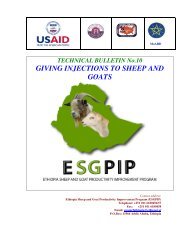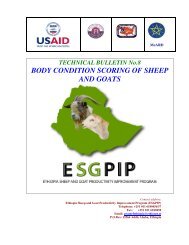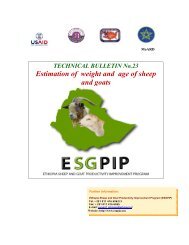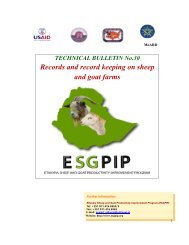Export requirement for live and meat of small ruminants - esgpip
Export requirement for live and meat of small ruminants - esgpip
Export requirement for live and meat of small ruminants - esgpip
You also want an ePaper? Increase the reach of your titles
YUMPU automatically turns print PDFs into web optimized ePapers that Google loves.
<strong>Export</strong> <strong>requirement</strong>s <strong>for</strong> <strong>meat</strong> <strong>and</strong> <strong>live</strong> <strong>small</strong> <strong>ruminants</strong>: How can developmentagents assist producers to improve <strong>small</strong> ruminant export?Prepared by: Ameha sebsibeEdited by: Alemu Yami, R.C. Merkel <strong>and</strong> T. A.Gipson1. IntroductionEthiopia is home to 63.3 million <strong>small</strong> <strong>ruminants</strong> (CSA, 2009). However, the <strong>live</strong>stock sub-sector’scontribution to the economy <strong>and</strong> <strong>for</strong>eign currency earnings in particular, is very low. Some <strong>of</strong> themajor factors contributing to the poor per<strong>for</strong>mance <strong>of</strong> the <strong>live</strong>stock sub-sector include widelyscattered <strong>and</strong> non-market oriented <strong>live</strong>stock production systems, lack <strong>of</strong> an efficient <strong>and</strong> effective<strong>live</strong>stock marketing system, poor market infrastructure, lack <strong>of</strong> proper transport services, <strong>and</strong>limited knowledge <strong>of</strong> <strong>and</strong> capacity to meet international st<strong>and</strong>ards by producers <strong>and</strong> marketers.Middle Eastern countries (Saudi Arabia, UAE, Kuwait, Yemen, Bahrain, Oman <strong>and</strong> Qatar) <strong>and</strong>Egypt imported, 10.7 million <strong>live</strong> <strong>small</strong> <strong>ruminants</strong> <strong>and</strong> nearly 0.27 million metric tons <strong>of</strong> <strong>meat</strong>,mainly from <strong>small</strong> <strong>ruminants</strong>, in 2007. This clearly shows that there is a large potential market <strong>for</strong><strong>small</strong> <strong>ruminants</strong> very close to Ethiopia. However, in 2009/10, Ethiopia exported only 333,271 <strong>live</strong>animals, 45% <strong>of</strong> which were <strong>small</strong> <strong>ruminants</strong> <strong>and</strong> only 9,192 tons <strong>of</strong> sheep <strong>and</strong> goat <strong>meat</strong> (EMDTI,2010). This is extremely low considering the country’s animal resource base, the proximity to themarket <strong>and</strong> the adaptation <strong>of</strong> the importers to the taste <strong>of</strong> our animals. There is also a high domesticdem<strong>and</strong> <strong>for</strong> <strong>small</strong> ruminant <strong>meat</strong>, particularly during religious festivals.The international market <strong>for</strong> <strong>live</strong> animals <strong>and</strong> <strong>meat</strong> is becoming increasingly competitive <strong>and</strong> relevantactors must adopt improved practices in production, transportation, processing <strong>and</strong> packaging <strong>of</strong>products to maintain <strong>and</strong> increase market share. It is imperative that <strong>small</strong> ruminant producers, buyers<strong>and</strong> processors be aware <strong>of</strong> the status <strong>and</strong> <strong>requirement</strong>s <strong>of</strong> the export market. Further, appropriatetraining should be provided to the <strong>live</strong>stock value chain actors to help them meet market <strong>requirement</strong>s<strong>and</strong> maximize the benefits from the growing <strong>meat</strong> <strong>and</strong> <strong>live</strong> animal export trade.2. Status <strong>of</strong> <strong>small</strong> ruminant export marketThe type <strong>and</strong> volume <strong>of</strong> <strong>small</strong> ruminant <strong>live</strong> animal <strong>and</strong> <strong>meat</strong> export <strong>and</strong> the destination markets aresummarized below.Preferred <strong>small</strong> ruminant breeds: According to abattoirs <strong>and</strong> <strong>live</strong> animal exporters, the Ethiopiansheep <strong>and</strong> goats breeds most preferred in the Middle East market are the Black Head Somali <strong>and</strong> Afarsheep. The Borena/Somali <strong>and</strong> Afar are among the most preferred goat breeds. The preferences tothese breeds may have been due the breeds’ lowl<strong>and</strong> background, their adaptation <strong>of</strong> the buyers to thecon<strong>for</strong>mation <strong>of</strong> the animals <strong>and</strong> the taste <strong>of</strong> the <strong>meat</strong>. However, when there is high dem<strong>and</strong> <strong>and</strong> the1
abattoirs are unable to fulfil orders <strong>for</strong> specific breeds, other breeds <strong>of</strong> <strong>small</strong> <strong>ruminants</strong> are alsoslaughtered <strong>and</strong> exported.Operational export abattoirs: As <strong>of</strong> early 2011, there are seven functional export abattoirs involvedin exporting <strong>small</strong> ruminant chilled <strong>meat</strong>. Two abattoirs (HELIMEX <strong>and</strong> ELFORA) are located inDebre Zeit, 45 km from Addis Abeba; three abattoirs (Luna, Modern <strong>and</strong> Organic) are located inModjo, 85 km from Addis Abeba. The ELFORA abattoir in Metehara is located (170 km from AddisAbeba) <strong>and</strong> the Abergele abattoir is in Mekele,700 km from Addis Abeba.Volume <strong>of</strong> export: Considering the resource base <strong>and</strong> other comparative marketing advantages <strong>of</strong>Ethiopia, the export volume to the Middle East has been low. However, the volume <strong>of</strong> both <strong>small</strong>ruminant <strong>meat</strong> <strong>and</strong> <strong>live</strong> export is growing in recent years. In 2009/10 Ethiopia exported nearly150,000 <strong>live</strong> <strong>small</strong> <strong>ruminants</strong> <strong>and</strong> 9,192 tons <strong>of</strong> chilled sheep <strong>and</strong> goat <strong>meat</strong>. Edible <strong>of</strong>fal such as<strong>live</strong>r, kidney, heart, tongue <strong>and</strong> brain were also exported. In addition, the Ethiopian Customs Officeestimates indicate that about 1.1 million sheep <strong>and</strong> goats are in<strong>for</strong>mally traded annually withneighboring countries.Major competitors <strong>of</strong> Ethiopia <strong>for</strong> the Middle Eastern market are shown in Table 1. Though most <strong>of</strong>these countries are very far from the importing countries, their volume <strong>of</strong> export is increasing. Thisincrease is mainly due to the countries meeting export sanitary/ <strong>requirement</strong>s, better economies <strong>of</strong>scale <strong>of</strong> <strong>live</strong>stock production, <strong>and</strong> well-in<strong>for</strong>med, capable value chain actors able to take advantage<strong>of</strong> the current market more so than traditional exporting countries such as Ethiopia.<strong>Export</strong> destinations: Small ruminant <strong>meat</strong> <strong>and</strong> <strong>live</strong> animals from Ethiopia are mainly exported tothe United Arab Emirates, Saudi Arabia, Kuwait, Bahrain, Yemen <strong>and</strong> Qatar. The United ArabEmirates <strong>and</strong> Saudi Arabia are the largest importers <strong>of</strong> <strong>live</strong> animals <strong>and</strong> chilled <strong>small</strong> ruminant<strong>meat</strong>.Table 1: Major competitors in the Middle Eastern market<strong>Export</strong> type Competitor Remark *Live Sheep Australia <strong>Export</strong>ed 3.8 million sheep to middle East in 2007BeefBrazil, India, ArgentinaSheep <strong>meat</strong>Australia, New Zeal<strong>and</strong>Sheep <strong>and</strong> goats India, Iran* FAOSTAT, 20073. Opportunities <strong>and</strong> challenges <strong>of</strong> the <strong>small</strong> ruminant export marketThe following are some <strong>of</strong> the important opportunities <strong>and</strong> challenges/constraints influencing the <strong>meat</strong>industry in Ethiopia, particularly the export sector.3.1 OpportunitiesLarge <strong>small</strong> ruminant population with diverse genotypes2
Proximity to Middle Eastern countries <strong>and</strong> adaptation <strong>of</strong> importing countries to the taste <strong>of</strong>Ethiopian animalsHigh dem<strong>and</strong> <strong>for</strong> <strong>small</strong> ruminant <strong>meat</strong> <strong>and</strong> <strong>live</strong> animals. The annual total <strong>meat</strong> dem<strong>and</strong> <strong>of</strong>Middle Eastern countries is about 207 thous<strong>and</strong> tons <strong>of</strong> <strong>meat</strong> <strong>and</strong> 12 million head <strong>of</strong> sheep,goats, cattle <strong>and</strong> camels. Based on the export data <strong>of</strong> 2009/10, Ethiopian exports filled only 3.4<strong>and</strong> 1.4 % <strong>of</strong> the <strong>meat</strong> <strong>and</strong> <strong>live</strong> <strong>small</strong> ruminant dem<strong>and</strong> <strong>of</strong> the Middle Eastern market,respectively. There is a large potential <strong>of</strong> exp<strong>and</strong>ing Ethiopian exports to the Middle East if thevalue chain actors in Ethiopia meet export market st<strong>and</strong>ards.Diverse agro-ecologies <strong>for</strong> production <strong>of</strong> different types <strong>of</strong> <strong>live</strong>stockGovernment interest <strong>and</strong> support to the <strong>small</strong> ruminant industryIncreasing number <strong>of</strong> export abattoirs <strong>and</strong> <strong>live</strong> animal exportersThe expansion <strong>of</strong> agro-industries <strong>and</strong> the increase <strong>of</strong> by-product feedstuffs allowing <strong>for</strong>enhanced productivity.3.2 Challenges/constraintsThe <strong>live</strong>stock production system is not market oriented resulting in lack <strong>of</strong> a constant <strong>and</strong>uni<strong>for</strong>m supply <strong>of</strong> marketable animalsLack <strong>of</strong> an efficient <strong>and</strong> effective <strong>live</strong>stock marketing system characterized by limitedmarket in<strong>for</strong>mation, absence <strong>of</strong> a <strong>live</strong>stock grading system to provide incentives to producers<strong>and</strong> limited promotion.Poor market infrastructure <strong>and</strong> lack <strong>of</strong> proper transport services,Limited knowledge by <strong>and</strong> capacity <strong>of</strong> value chain actors (producers, dealers, transporters,<strong>meat</strong> h<strong>and</strong>lers, etc.) to meet international market st<strong>and</strong>ards.Prevalence <strong>of</strong> <strong>live</strong>stock diseases <strong>and</strong> inadequate veterinary support services. There have beenfrequent export bans mainly due to the stringent health <strong>requirement</strong>s <strong>of</strong> some importingcountries.Poor feed supply <strong>and</strong> low feed qualityInadequate application <strong>of</strong> HACCP (Hazard Analysis <strong>and</strong> Critical Control Points) protocols inabattoirs <strong>and</strong> export marketsAnother important constraint affecting <strong>small</strong> ruminant value chain actors is limited access to marketin<strong>for</strong>mation at the grassroots level. Pastoralists <strong>and</strong> traders lack clear <strong>and</strong> detailed knowledge on thedesired <strong>live</strong>stock characteristics <strong>and</strong> health <strong>requirement</strong>s <strong>of</strong> importing countries. Further, theseproducers are also not adequately in<strong>for</strong>med <strong>of</strong> the importance <strong>of</strong> establishing source <strong>of</strong> origin,traceability mechanisms, <strong>and</strong> related certification processes <strong>for</strong> marketed animals. Chain actors donot yet appreciate the importance <strong>of</strong> issues related to food quality, the link between animal health,<strong>meat</strong> quality <strong>and</strong> safety, <strong>and</strong> why documentation is fundamental in enhancing competitiveness inthe global market.The extensive production systems that dominate <strong>small</strong> ruminant production in Ethiopia not onlyinhibit producer access to market in<strong>for</strong>mation, but limits the learning process on production changesrequired to meet the quality dem<strong>and</strong>s <strong>of</strong> the export market. Improved horizontal linkages among thepastoralists would improve their capacity to share in<strong>for</strong>mation <strong>and</strong> learn/harmonise on common3
strategies <strong>for</strong> responding to the market. Vertical linkage between traders <strong>and</strong> producers to nationalinstitutions in terms <strong>of</strong> both <strong>for</strong>wards <strong>and</strong> backwards in<strong>for</strong>mation flow is poor. Strengthenedagribusiness linkages would improve the efficiency to respond to market dem<strong>and</strong>s.The existing <strong>live</strong>stock producers <strong>and</strong> traders associations are not well organised <strong>and</strong> structured toprovide the necessary support services to facilitate effective linkages with <strong>for</strong>mal markets to theirmembers.4. Important considerations to improve <strong>small</strong> ruminant export4.1. ProducersPastoralists/producers should raise animals that yield high quality <strong>and</strong> high value products <strong>and</strong> h<strong>and</strong>leanimals with due consideration at all times <strong>and</strong> with minimal use <strong>of</strong> <strong>for</strong>ce <strong>for</strong> economic reasons relatedto <strong>meat</strong> quality as well as to meet animal welfare st<strong>and</strong>ards.Genetic factors: Many physical properties <strong>of</strong> <strong>meat</strong>, such as tenderness, are greatly influenced bygenetic factors. Producers can make improvements to the end quality <strong>of</strong> <strong>meat</strong> by careful selection<strong>of</strong> <strong>small</strong> ruminant breeds <strong>and</strong> strains within a particular breed.Age <strong>and</strong> weight: Meat quality changes markedly with an animal’s age or weight at slaughter.Hence, producers should know the weight preference <strong>of</strong> export abattoirs <strong>and</strong> the major season thatfetches a better price per kg <strong>of</strong> <strong>live</strong> weight to target their production. Regarding <strong>small</strong> ruminant<strong>live</strong> export, the dem<strong>and</strong> is highest during Eid Al-Adha (Arafa). The price per kg <strong>live</strong> weight isalso higher <strong>for</strong> this festival than other times <strong>of</strong> the year as many families will sacrifice an animalduring this period. The preferred weight category is between 25-30 kg or more with goodcondition as animal shipping to Saudi Arabia requires about one week. <strong>Export</strong> abattoirs requiresheep/goats weighing 15-30 kg (depending on the <strong>requirement</strong>s <strong>of</strong> the importing country)throughout the year including <strong>for</strong> the Ramadan festival.Table 2. Requirement <strong>of</strong> some importing Middle East <strong>and</strong> Asian countries <strong>for</strong> <strong>small</strong> <strong>ruminants</strong>ConsumersMiddle East (Saudi Arabia <strong>and</strong> Dubai)MalaysiaMalaysiaTaiwanProduct specificationSkin-<strong>of</strong>f carcassmutton: 8–12 kg;goat: 5–7.5 kgSkin-<strong>of</strong>f, lean carcass,
.Fig.1 Ethiopian goat <strong>meat</strong> cuts in a Dubai super market (Photo: Ameha Sebsibe)Nutrition: The general feeding practice in Ethiopia is to graze all <strong>live</strong>stock together oncommunal or privately owned grazing l<strong>and</strong> with all animals subjected to similar constraintsimposed by overgrazed pastures. Culling unproductive animals is a practice not usuallyemployed by most producers. Currently, the majority <strong>of</strong> indigenous sheep marketed have low<strong>live</strong> weight resulting in a poor dressing percentage <strong>and</strong> carcasses with little fat cover. Technicalassistance to improve animal nutrition using available feed ingredients should be provided toproducers. Enhanced feeding technologies can help <strong>live</strong>stock owners produce lambs/kids thatare heavier at slaughter with greater quantity <strong>and</strong> improved quality <strong>of</strong> <strong>meat</strong>.Sex: The Gulf markets are only interested in male <strong>small</strong> <strong>ruminants</strong> <strong>for</strong> both <strong>meat</strong> <strong>and</strong> <strong>live</strong> imports.Minimizing hazards found in animals <strong>and</strong> <strong>meat</strong>: Development agents can assist producers inminimizing or eliminating significant hazards to production through creating awareness <strong>and</strong>/ ortraining.‣ Biological hazards are minimized by maintaining the health <strong>of</strong> the animal includingproviding vaccinations <strong>and</strong> proper health care. Maintain animal pens <strong>and</strong> corrals to preventinjury to animals that could allow entry <strong>of</strong> disease organisms.‣ Chemical hazards <strong>of</strong> most concern in <strong>meat</strong> are drug residues. Only drugs approved <strong>for</strong> usein <strong>small</strong> <strong>ruminants</strong> should be used <strong>and</strong> then only under supervision <strong>of</strong> an animal health<strong>of</strong>ficial. Withdrawal times (the time needed <strong>for</strong> a drug to clear from an animal’s system)<strong>for</strong> <strong>meat</strong> has been set <strong>for</strong> most drugs should be strictly followed <strong>and</strong> no animal slaughtered<strong>and</strong> consumed during the withdrawal period. Chemical contamination can also come fromanimals eating feed with fertilizer, pesticide, or herbicide residues. Be careful when usingchemicals <strong>and</strong> do not feed grain, hay, or grass that may have been contaminated.‣ Physical hazards are not common in <strong>meat</strong> animals coming <strong>of</strong>f farm. However, brokenneedles are one example <strong>of</strong> a physical hazard that can be prevented on-farm. Careshould thus be taken when injecting animals. All injections (subcutaneous,5
intramuscular, <strong>and</strong> intravenous) should be given in the neck area in front <strong>of</strong> the shoulder,never inject an animal on the rear leg. Injection site lesions (areas <strong>of</strong> toughened scartissue resulting from an injection) can <strong>for</strong>m in muscle. This portion <strong>of</strong> the <strong>meat</strong> must becut out <strong>and</strong> discarded after slaughter. This affects animal price <strong>and</strong> the <strong>small</strong> ruminant<strong>meat</strong> industry particularly the export market negatively.4.2 Traders, Middlemen <strong>and</strong> TransportersTraders, middlemen <strong>and</strong> transporters purchase <strong>small</strong> <strong>ruminants</strong> to supply slaughter houses or <strong>live</strong>animal exporters. Both <strong>meat</strong> <strong>and</strong> <strong>live</strong> animal exporters require quality animals to fetch better prices, tomaintain their customers’ interest, <strong>and</strong> stay competitive in the market. Maintaining high quality inanimals purchased <strong>and</strong> products sold is important in ensuring pr<strong>of</strong>it to all sectors <strong>of</strong> the <strong>live</strong>stockanimal <strong>and</strong> product business. Moreover, the country also benefits from the influx <strong>of</strong> <strong>for</strong>eign currencythrough revenue gained by exporting animals <strong>and</strong> <strong>meat</strong>. Thus, all ef<strong>for</strong>ts should be made to improvethe volume <strong>and</strong> quality <strong>and</strong>, hence, the value <strong>of</strong> <strong>meat</strong> <strong>and</strong> <strong>live</strong> animal export. Traders, middlemen <strong>and</strong>transporters should ensure humane h<strong>and</strong>ling <strong>of</strong> animals when purchasing from the market, at holdinggrounds, <strong>and</strong> during transportation. Care should be taken when loading animals to avoid bruising.Animals should not be overcrowded on <strong>live</strong>stock trucks <strong>and</strong> arrangements <strong>for</strong> feeding, watering <strong>and</strong>resting during transport to an abattoir or collection yard <strong>for</strong> <strong>live</strong> export need to be made. Developmentagents/district <strong>of</strong>fices <strong>of</strong> the Bureau <strong>of</strong> Agriculture, in collaboration with their respectivemunicipalities, could arrange awareness creation programs/training on transportation <strong>and</strong> appropriateh<strong>and</strong>ling <strong>of</strong> sheep <strong>and</strong> goats.4.3. Complying with buyer’s Sanitary <strong>and</strong> Phytosanitary <strong>requirement</strong>sThe sanitary <strong>and</strong> phyto-sanitary (SPS) <strong>requirement</strong>s <strong>of</strong> the Office International des Epizooties (OIE),a referral institution <strong>of</strong> the World Trade Organization <strong>and</strong> the importing countries must be followedto gain entry <strong>and</strong> maintain share in export markets. The export-oriented <strong>meat</strong> processing plantsshould follow the excellent sanitary <strong>and</strong> phyto-sanitary measures given by the OIE. The plants need tobe certified with HACCP, ISO-9002, <strong>and</strong> other required st<strong>and</strong>ards to meet OIE norms.Measures <strong>for</strong> <strong>meat</strong> safety begin at the primary production level, be it a farmer raising 5– 20 animals ora larger number <strong>of</strong> animals in a feedlot. The identification <strong>and</strong> traceability <strong>of</strong> the animals fromproduction source to the abattoir needs to be maintained. It must be ensured that animals have beenraised free <strong>of</strong> “List A” diseases as defined by OIE, like Foot <strong>and</strong> Mouth Disease, PPR, etc.Requirements <strong>for</strong> import are different <strong>for</strong> different countries. However, one <strong>of</strong> the common<strong>requirement</strong>s <strong>of</strong> all the countries importing <strong>live</strong> animals <strong>and</strong> animal products is fulfillment <strong>of</strong> SPS<strong>and</strong> related issues that must be confirmed by provision <strong>of</strong> health certificates issued by a regulatingbody. The following are some <strong>of</strong> the major <strong>requirement</strong>s that need to be fulfilled in order to obtainproduct entry permits <strong>for</strong> some Gulf countries. (UAE, Ministry <strong>of</strong> Environment <strong>and</strong> Water, 2010)1. The health <strong>and</strong> other certificates issued <strong>for</strong> animals <strong>and</strong> animal products export mustindicate that the animal or <strong>meat</strong> is free from diseases, safe <strong>and</strong> fit <strong>for</strong> human consumption,i.e., without harmful levels <strong>of</strong> chemical, biological or antibiotic residues in the <strong>meat</strong>, <strong>and</strong>have an original veterinary health certificate;6
2. Animals must be quarantined <strong>for</strong> 21-30 days be<strong>for</strong>e slaughtering or <strong>live</strong> export;3. Animals should be vaccinated twice <strong>for</strong> FMD <strong>and</strong> once <strong>for</strong> PPR (sheep <strong>and</strong> goats);4. Animals should be transported in cleansed <strong>and</strong> disinfected vehicles;5. Animals should be slaughtered in an approved slaughter house;6. Animals or products must have a certificate <strong>of</strong> country <strong>of</strong> origin;7. Halal products must carry the appropriate certificate; <strong>and</strong>8. The <strong>meat</strong> must not be mixed with any other animal products.9. The carcass should be completely eviscerated <strong>and</strong> submitted to maturation at temperatureabove +2°C <strong>for</strong> a minimum period <strong>of</strong> 24 hours following slaughter.10. Meat must come from young <strong>and</strong> intact male animals.5. How can development agents assist producers to improve <strong>small</strong>ruminant export?Provision <strong>of</strong> in<strong>for</strong>mation:‣ Make <strong>small</strong> ruminant producers, producer cooperatives, dealers, traders <strong>and</strong> transportersaware <strong>of</strong> the high dem<strong>and</strong> <strong>of</strong> the Gulf market <strong>for</strong> <strong>live</strong> animals <strong>and</strong> <strong>meat</strong> <strong>of</strong> <strong>small</strong> ruminant<strong>and</strong> the marketing potential that exists.‣ Provide in<strong>for</strong>mation on the current <strong>small</strong> ruminant animal <strong>and</strong> <strong>meat</strong> export volume <strong>and</strong>value <strong>and</strong> the market <strong>requirement</strong>s along the value chain, particularly those dealing with theprevention <strong>and</strong> control <strong>of</strong> animal diseases.‣ Collaborate with the branch <strong>of</strong>fices <strong>of</strong> the Ministry <strong>of</strong> Road Transport Authority <strong>and</strong>transporters’ associations to better provide in<strong>for</strong>mation to the transport sector on appropriateanimal transport.‣ Sheep <strong>and</strong> goats should not be fed with <strong>meat</strong> <strong>and</strong> bone meal <strong>and</strong> need not be treated withgrowth promoters.Assistance to sheep <strong>and</strong> goat producers:‣ Orient <strong>and</strong> train producers on the need <strong>and</strong> ways <strong>of</strong> market orientation <strong>and</strong> targeting <strong>of</strong>sheep <strong>and</strong> goat production‣ Provide training on the market <strong>requirement</strong>s <strong>for</strong> sheep <strong>and</strong> goats including the weightpreference <strong>of</strong> export abattoirs <strong>and</strong> the major season that fetches a better price per kg <strong>of</strong> <strong>live</strong>weight.‣ Assist in dissemination <strong>of</strong> <strong>live</strong>stock market in<strong>for</strong>mation to producers throughstrengthening pastoralists’ organizations‣ The domestic market <strong>for</strong> lowl<strong>and</strong> animals is very limited whereas the market dem<strong>and</strong> inthe Gulf <strong>for</strong> lowl<strong>and</strong> <strong>small</strong> <strong>ruminants</strong> is high provided the market <strong>requirement</strong> is met.Development agents can assist pastoralists/producers/producers’ cooperatives byproviding in<strong>for</strong>mation on the type <strong>of</strong> animals that have more dem<strong>and</strong>, productioncalendars <strong>for</strong> <strong>small</strong> <strong>ruminants</strong> to target major Gulf market seasons such as <strong>for</strong> Eid Al-Adha (Arafa), Ramadan <strong>and</strong> other times. Development agents can have direct discussionwith the <strong>live</strong> animal <strong>and</strong> <strong>meat</strong> exporters to obtain in<strong>for</strong>mation <strong>and</strong> devise the calendars.7
‣ Identify progressive agro-pastoralists/pastoralists/producers/producers’ cooperatives <strong>and</strong>assist them to <strong>for</strong>m linkages with <strong>live</strong> animal <strong>and</strong> <strong>meat</strong> exporters. Contractual agreementscan be made detailing the type <strong>of</strong> <strong>small</strong> <strong>ruminants</strong>, required number, desired weight, time<strong>of</strong> de<strong>live</strong>ry, price, <strong>and</strong> method <strong>of</strong> payment. To model successful <strong>and</strong> sustained contractagreements, the DA should first select some lowl<strong>and</strong> areas with business oriented agropastoralists/pastoralists/producers/producers’cooperatives. The success <strong>of</strong> these groupscan then be used to encourage other producers through arranging field days <strong>and</strong> visits.Further, the DA, in collaboration with the <strong>live</strong>stock extension staff <strong>of</strong> the regionalBureau, can negotiate advance contract payments from buyers that will enable agropastoralists/pastoralists/producers/producers’cooperatives to purchase the required inputs<strong>and</strong> produce the agreed numbers <strong>of</strong> <strong>small</strong> <strong>ruminants</strong>.Assist producers in producing safe <strong>and</strong> wholesome <strong>meat</strong> by training them to:‣ provide proper care to their animals i.e. feed them well; give them clean water to drink;house them well; get them vaccinated in time etc.‣ use all drugs correctly <strong>and</strong> follow withdrawal times;‣ refrain from injecting animals in the rear muscle or loin; <strong>and</strong>‣ use pesticides <strong>and</strong> other chemicals carefully to prevent contaminating animal feeds.‣ Arrange visits <strong>for</strong> selected progressive sheep <strong>and</strong> goat producers <strong>and</strong> cooperatives to exportabattoirs to help them better underst<strong>and</strong> the consequences <strong>of</strong> poor management <strong>and</strong> h<strong>and</strong>ling<strong>of</strong> animals <strong>and</strong> also the positive influence <strong>of</strong> improved management <strong>and</strong> humane h<strong>and</strong>lingon <strong>meat</strong> yield <strong>and</strong> quality.Assist producers/producers’ cooperatives to select appropriate breeds <strong>and</strong> productiontechnologies, target markets, <strong>and</strong> increase the <strong>of</strong>f-take as well as productivity per animal toensure a constant <strong>and</strong> uni<strong>for</strong>m supply <strong>of</strong> <strong>meat</strong>.The KDA could assist on simple ways <strong>of</strong> protecting animals from trade related <strong>live</strong>stockdiseases. Moreover, he/she can make arrangements <strong>for</strong> timely de<strong>live</strong>ry <strong>of</strong> vaccinationsagainst major infectious diseases.Assist producers to establish <strong>and</strong> maintain records across a broad spectrum <strong>of</strong> farmingactivities that enables the producer to plot his/her progress in terms <strong>of</strong> production levels,income, state <strong>of</strong> the environment <strong>and</strong> other parameters.6. ReferencesCSA. 2009. Central Statistics Authority, Ethiopia, Addis AbabaEMDTI. 2010. Ethiopian Meat <strong>and</strong> Dairy Technology Institute. Annual report <strong>of</strong> 2010.FAOSTAT. 2007UAE. 2010. Report <strong>of</strong> the Ministry <strong>of</strong> Environment <strong>and</strong> Water,. Dubai.8



